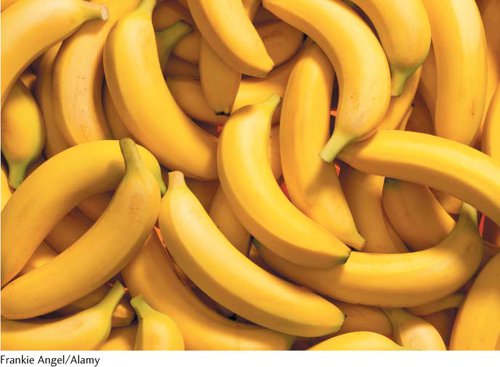6
Chromosome Variation
Building a Better Banana

Bananas and plantains (collectively referred to as bananas) are the world’s most popular fruit. In many developing countries, they are a critically important source of food, providing starch and calories for hundreds of millions of people. In industrial countries, more bananas are consumed than any other fruit; for example, Americans consume as many pounds of bananas as apples and oranges combined. Over 100 million tons of bananas are produced annually worldwide.
There is no concrete biological distinction between bananas and plantains, but the term “banana” generally refers to the sweeter forms that are eaten uncooked, while the term “plantain” is applied to bananas that are peeled when unripe and cooked before eating. Cultivated bananas differ from their wild relatives by being seedless, which makes them more edible but hinders their reproduction. Farmers propagate bananas vegetatively, by cutting off parts of existing plants and coaxing them to grow into new plants. Because they are propagated by this method, many cultivated bananas are genetically identical.
From a genetic standpoint, bananas are interesting because many varieties have multiple sets of chromosomes. Most eukaryotic organisms in nature are diploid (2n), with two sets of chromosomes. Others, such as fungi, are haploid (n), with a single set of chromosomes. Cultivated bananas are often polyploid, with more than two sets of chromosomes (3n, 4n, or higher). Most strains of cultivated bananas were created by crossing plants within and between two diploid species: Musca acuminata (genome = AA) and Musca balbisiana (genome = BB). Many cultivated bananas are triploid, with three sets of chromosomes, consisting of AAA, AAB, or ABB, and some bananas even have four sets of chromosomes (tetraploid), consisting of AAAA, AAAB, AABB, or ABBB.
In spite of their worldwide importance as a food, modern cultivated bananas are in trouble. The strain most often sold in grocery stores—
To help develop a better banana—
Most species have a characteristic number of chromosomes, each with a distinct size and structure, and all the tissues of an organism (except for gametes) generally have the same set of chromosomes. Nevertheless, variations in chromosome number—
We begin this chapter by briefly reviewing some of the basic concepts of chromosome structure that we learned in Chapter 2. We then consider the different types of chromosome mutations and their features, phenotypic effects, and influences on evolution.